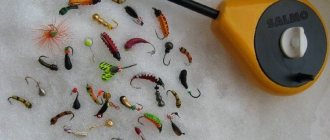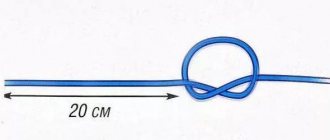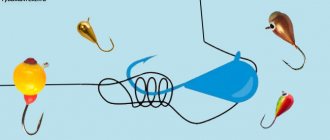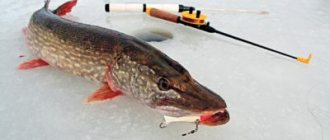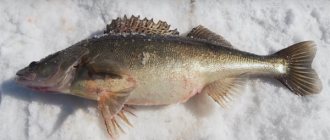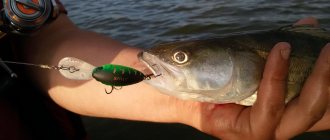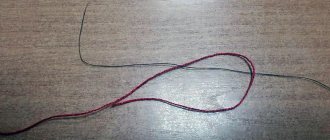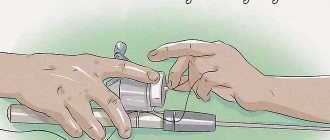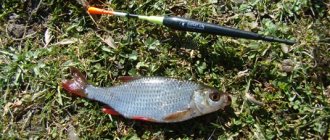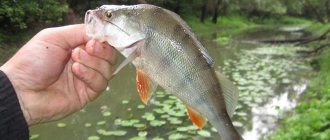There are many ways that will allow us to tie a jig correctly. A well-tied tackle gives us a high chance of a rich catch, since the correct hooking depends on this. It is also necessary to compare the size of the bait and the weight of the desired prey.
Usually, this procedure does not cause any difficulties for experienced fishermen, while for beginners it can cause some problems due to the fact that novice fishermen may not know all the intricacies of fishing with this gear. However, everything is very simple.
A few recommendations before tying a jig:
- You need to choose the right bait. Each fish has its own taste preferences, so it is highly recommended to prepare several types of different bait.
- It is advisable to buy good and durable gear.
- In addition, you need a good drill to drill a hole.
- And, undoubtedly, the most important thing is to be able to tie the tackle correctly, otherwise it will simply break off at the most important moment.
How to tie a jig to a fishing line:
- We insert the end of the fishing line through the hole in the tackle.
- Next, the fishing line must be tied in a knot. To make the knot strong, you need to make five turns around the loop.
- The loop should be placed on the shank of the hook and made a knot.
- At the end of the procedure, we cut off the excess fishing line that protrudes from the hole.
What is a jig?
The jig not only performs the functions of a bait, but in fact can also be considered a sinker. The fishing line is always in a taut state. This property allows you to play a quality game when fishing.
This gear imitates the behavior of insects in water, which are food for fish. Therefore, the game during the fishing process is of great importance.
Lead, tungsten, copper, tin, brass or silver are often used for manufacturing. The number of hooks may vary. It varies from one to four. It is generally accepted that the quality of the game is higher for jigs that have one or two hooks.
An exception may be the case when the treble hook is made not soldered, but suspended. Then its vibrations will allow you to more effectively attract fish.
Jigs can be roughly divided according to their sizes:
- small, the size of which does not exceed 5 millimeters;
- medium - from 5 to 9 millimeters;
- large ones have a size that exceeds 9 millimeters.
This fishing tackle has a long history; it was mentioned back in the nineteenth century. Nowadays there is a huge variety of jigs on sale in various types, colors and sizes and made from various materials. How to choose the option that suits best?
How to tie jigs with a train
In order to tie jigs with a locomotive consisting of two or three jigs, you can use simple locking fishing knots, which have a low loss of strength and another important advantage.
If you tie a pair of light jigs to the tackle above a heavy bait like a locomotive, they will sink to the bottom much slower than a lead end jig, say a lead or tungsten jig. To do this, two locking knots should be tied to the fishing line of the tackle, following each other at a certain distance.
But the structure of light jigs tied with a train should be horizontal, the holes in the baits should be minimal. Fishing stopper knots can be used to support jigs in the form of a “droplet,” “pellet,” or “ovinka” from below with a locomotive.
Just this method of fixing two jigs on the main line with a “train” using two locking fishing knots is shown in the image on the left.
On the last page of this topic, you can select a stopper assembly suitable for forming jigs into a locomotive.
Each jig attached to a train is obtained in a sliding version of the equipment. The thinner the line or leash on the tackle and the larger the diameter of the through hole in the jig, the more turns there should be in the fishing knot.
But, in principle, it is possible to use jigs with large diameter through holes for a locomotive, without weakening the strength of the line in the knot with extra turns.
To do this, when forming a stop knot, say, from 4 turns of thin fishing line, simply insert a small bead in the middle of the winding turns.
Or, to put it more clearly, to form a train out of jigs, you simply need to tie a small bead of glass beads under each bait.
Due to the fact that the jigs are not tied rigidly, twisting of the fishing line is eliminated during the fishing process, but each jig of the locomotive can spin as desired, and at a certain moment the nozzle on its hook can be right in front of the “nose” of the fish.
Jigs for fishing with attachments
In this case, the role of the game is somewhat reduced. The fish may be attracted by the bait rather than the game. Although, in fishing there are no universal tips and the experience of the fisherman plays a big role. You will also notice that color is much less important here too. If the fish is not active, it is more likely to be attracted to dark colors.
The most popular in this case are “pellet” jigs..
Although any other types of such gear can be effectively used.
Nozzle-less jigs or “reelless jigs”
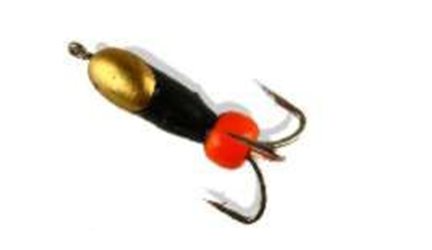
There are several different types of such jigs:
- One of the varieties is called “devil”" This type of tackle looks like an elongated drop. One of its features is that it has three hooks attached to it, not just one. Often this tackle is complemented by the use of a bright bead, which is located between the hooks and the jig itself. In water, the jig takes a vertical position and moves up and down during the game. Wiring must be done at high frequency. This is the only way this type of jig can effectively attract fish.
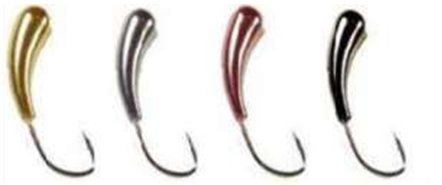
- Another popular variety is called “uralka” . Its shape resembles a slightly curved drop. These jigs are equipped with only one hook. In water, the tackle deviates approximately 45 degrees. Effective when using high-frequency wiring. When playing, he makes movements in both vertical and horizontal planes.
- The “goat” jig is somewhat reminiscent of the Ural jig, but, unlike it, it is equipped with two hooks, not one.
- Another jig that has become widespread is the “ant” . It got its name because of its shape, which consists of two or three thickenings connected by narrow bridges. This tackle is used with one hook.
- The “carnation” has a rather original design . It is a small metal rod along which a metal ball can move freely. During the game. It walks freely along the rod, hitting the edges and attracts fish with its noise.
- Lately, the “cat’s eye” jig has been gaining more and more popularity . Wiring, when used, must be aggressive in nature. Usually the amplitude of oscillations is small, with frequent small pauses. In cases where the fish is not active enough, it is recommended to change the type of wiring. A slow game with rare and long pauses will be effective. During the reeling process, the ball knocks on the hook, creating a sound that can attract fish. The color of the ball is important. Different colors make the tackle attractive to different types of fish. Bream prefers a milky-white ball; sorog or elm peck on green balls.
- There are also quite a large number of other popular reelless jigs . Examples include: banana, oatmeal, drop and a number of other varieties.
Hooks on a jig
In most cases, a tackle with one hook is used. Some jigs can contain up to four hooks. In some cases, the hooks are soldered, while in others they are attached using a loop. If we talk about the first option, then jigs with one or two hooks have the best game.
A tackle equipped with three hooks, due to its symmetry, moves only vertically, either up or down, when playing. A jig with four hooks moves the most ponderously compared to other varieties.
You need to be able to control the correct placement of the hook. It is incorrect when its tip is tilted towards the axis . In fact, it is correct when it is located parallel to it. If the length of the hook is too short, then it is difficult to expect a good catch.
With a normal length, the tip of the hook is located at some distance from the jig itself.
How to tie a pair of jigs on one line
In fact, the performance of both baits can become noticeably worse and lose their attractiveness. In addition, it becomes difficult to win the trophy due to the risk of another jig catching on the edge of the hole with its free sharp hook. However, for those who are truly interested in the question of how to attach two baits to a winter fishing rod, we will suggest a good reliable solution.
So, the lower jig should be heavier than the upper one so that there are no distortions in the structure. It is attached in any of those ways that are known to you. The upper one is mounted on a leash (about 15 cm long) and attached to the main fishing line, approximately 40 centimeters from the lower one. Therefore, the logical answer to the question “how to tie 2 jigs” would be the situation when the top bait moves away from the working line, instead of getting tangled in it and interfering with fishing. The leash can be secured using the usual “loop to loop” technique.
Storing jigs
Since a lot of jigs are required for fishing, it is necessary to ensure their proper storage. The easiest way is to use small boxes with a piece of polyurethane or cork. Polystyrene foam should not be used for this purpose. This is due to the fact that it can cause rust on the hooks.
Before storing, the jig must be thoroughly cleaned, rinsed and thoroughly dried . This is primarily due to the fact that if this is not done, then, for example, the remains of the nozzle can lead to damage to the gear.
An alternative “hook” method of tying both types of jigs
Any jig - be it a tungsten jig with an eye, or a lead jig with a hole - can be tied to the hook without forming a knot completely on the fore-end, but only by fixing it there. The result is a kind of alternative to the classic leader knot and “spindle”.
Advantages:
- It is noticeably easier to knit than a knot on a hook, this is especially noticeable on reelless jigs with bait. And especially in field conditions, where this unit is usually in demand.
- In fact, it does not take up any space on the forend, which is very good for reelless rifles with refills. This knot has virtually no effect on the movement of the beads.
Flaws:
- The strength of the knot is inferior to the classic one, because the coil with which it is fixed to the fore-end experiences maximum loads.
How to tie correctly?
Proper tying of the jig is very important. The point here is not only the strength of the connection, but also the fact that with some methods the fishing line can simply fray during fishing. This is especially important when using tackle made from tungsten.
Here we will tell you how to properly tie this fishing tackle.
To do this, it should be noted that several different situations are possible:
- Often a through hole is made in the jig , through which a fishing line is passed, which is then tied to the hook itself.
- Another situation occurs when the jig is made of a very hard material, an example of which is tungsten. In this case, we are also talking about a through hole, but its edges are sharp enough to cut the fishing line over time.
- Another fastening option is a loop soldered into the tackle.
Before preparing your tackle, you must keep in mind the following rules:
- The bait must be chosen correctly . There are a large number of varieties, which is usually difficult to navigate. Usually, several different options are purchased and those that have shown the greatest effectiveness are used.
- Initially, you need to purchase gear that is not only high-quality , but also durable and reliable.
- During winter fishing, fishing occurs through holes drilled in the ice. Therefore, an important tool will be the drill with which you will do this.
How to attach a fishing line to a jig that has a through hole?
- First you need to pass the fishing line through it.
- Then the free end must be tied around the hook. In this case, the number of revolutions should be from three to five .
- The resulting knot must be tightened tightly.
Attaching the fishing line where the ring is provided
- We thread the line through the loop, which is usually located at the top of the jig.
- We wrap the end of the fishing line three to five times around the shank of the hook.
- We thread the free end into the loop that formed at the bottom of the knot.
- Tighten this knot.
How to attach fishing line to tungsten tackle?
The binding method itself does not change. It is necessary to protect the fishing line from contact with the sharp edges of the hole.
There are two main methods for this:
- The jig is attached to the hook with braiding in such a way as to leave a loop on the outside. The fishing line itself will be attached to it.
- from such a wire or something similar is threaded inside the hole This is done in such a way that it protrudes slightly beyond the jig. Then a fishing line is threaded inside. There are also tungsten jigs with special inserts on sale, but, unfortunately, they fray over time.
We tie a jig without an eye
Often fishermen are faced with a problem when they cannot figure out how to tie a jig without an eye. But there is no particular problem with this, you just need to understand the basic basics and know how to tie a hook with a spatula and use the same knots.
The following installation option is especially popular among fishermen:
- The main line must be threaded through the through hole in the jig.
- Then the working end of the fishing line must be passed along the fore-end.
- After this, you need to turn it in a loop through the rounding.
- Now you need to draw the line in the opposite direction.
- Unfold the line near the lead ball of the jig.
- Wrap the working end 3-5 times around the forend.
- Thread the end of the line through the loop created at the bottom of the hook (as shown in the photo below).
- Moisten and tighten the knot.
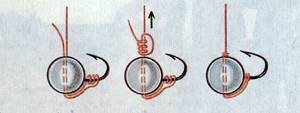
This is one of the most reliable and good ways to connect a fishing line with a jig without an eyelet for fastening. The method is quite simple and has a lot of advantages, and it can also be used for braiding.
Fishing from ice with a winter jig
In order to start fishing, you first need to find a place where this can be done. Some inexperienced fishermen use a simple, but not particularly effective method - they look for a place where fishermen are crowded. Usually, in this case, two or three people effectively catch, and the rest simply observe the fishing process.
How to act effectively in such a situation? In the dead of winter, fish prefer those places where there is at least a little more oxygen dissolved in the water than everywhere else around. Such places are well known.
Fishing with jigs in winter will work better in the following places:
- underwater keys;
- river mouths;
- places where there are sharp changes in depth (for example, edges);
- places with complex bottom topography, trunks or underwater concrete structures;
- places where there is abundant underwater vegetation.
You can make several holes in different places, feed the fish there and periodically cast a fishing rod in each of them. So sooner or later you can find a place where there will be a good bite.
Roach tackle
The effectiveness of different types of jigs differs in different winter periods.
How to catch roach in winter using a jig:
- First ice. At this time, not only ants, but also witches and devils showed the greatest effectiveness among jigs. Dark color proved to be more effective. Black, purple or dark green gear is suitable.
- In the wilderness, the fishing situation worsens. At this time the fish is very passive. She practically doesn't feed. Therefore, it is quite difficult to attract her. A jig with a bloodworm attachment can give you a certain chance of catching. It is recommended to choose the smallest size tackle.
- When the last ice arrives, small jigs are also recommended. What jig should I use to catch roach in winter at this time? It is a good choice to use small tungsten pellets.
How to catch perch in winter with a jig?
First of all, we note that in winter, perch is one of the most numerous and active fish. Therefore, it is difficult to imagine a fisherman who loves winter fishing and does not pay enough attention to this fish.
Which jig is better to fish in winter:
- Devils. Although the classic version provides for the presence of three hooks, there are varieties with two or four hooks. The former are usually called witches, and the latter are also called devils. This baitless jig is considered one of the most effective for winter perch fishing. Moreover, the same applies to other types of fish. It should be taken into account that such a jig requires a special nod and a special game with the bait in order to show its effectiveness. One possible way to play is as follows. You need to lower the devil to the bottom and play vertically three to four times. Then freeze. Usually the fish attacks the bait at this moment.
- Another variant of catchable jigs is called “amphip” . It is good for catching not only perch, but also roach.
- Uralka can be used both with and without an attachment. It also consistently catches bream and roach. Available in various versions, but most of them are capable of showing good results.
When we talk about which jigs to use to catch perch in winter , a definite answer is hardly possible; we have given here only some of the possible answers.
Equipment for fishing with a steam locomotive
The success of any fishing is determined by well-chosen tackle. You should choose a fishing rod with a reel in such a way that all the equipment with several baits is optimally positioned, and there are no difficulties when casting and retrieving.
- In order for the nod to have sufficient sensitivity, its length is selected taking into account the fishing conditions. The value can vary between 100-150 mm. The material for making the nod is selected depending on the number of baits. If the “locomotive” is relatively small and light, then a plastic nod is sufficient. When a lot of baits are used and the “locomotive” is heavy, preference should be given to a metal nod.
- Based on the total weight of the lures, not only the type of nod is determined; it is taken into account when selecting a fishing line, giving preference to diameters of 0.10-0.18 m. The selected option should provide tension on the fishing line with the lures, which will ensure a good game.
- There are many options for selecting and combining baits for such gear. A tandem of two “devils” is considered effective. Various combinations of their weight and size make this combination very catchy. The main thing is that each such combination requires its own game.
- The classic “locomotive” made from a jig and a “devil” has also proven itself well; The tackle with a massive “devil” at the bottom and a small jig at the top is especially productive. For greater attractiveness, one or more beads are installed on the jig, the colors of which would differ sharply from each other.
We invite you to familiarize yourself with Black maggots
The main advantage of such gear as the “locomotive” is the ability to fish several water horizons at the same time, which increases the effectiveness of the gear several times, which is reflected in a greater number of bites than with other gear. You can read the material about the types and characteristics of winter fishing rods.
In addition, by varying the distance, number and size of baits attached to the fishing line, you can not only cover all depths, but also study the preferences of the inhabitants of the underwater kingdom in terms of the size of the bait. Some fish prefer large and clearly visible “devils”, while others have a greater appetite for medium and small jigs. You can read the material about winter fishing techniques.
The variety of baits in the “locomotive” is one of the main factors in its catchability. Very often, many fishermen limit the number of baits in a given tackle, so as not to make it a simple pile of jigs, which should give the tackle a characteristic game, while ridding it of some “clumsy” roughness and features of poaching tools, designed to accidentally catch a large number of fish swimming nearby hooks We recommend reading the article about winter skating.
However, this approach is wrong. The baits in the “locomotive” are in a kind of connection, mutually influencing each other, creating various, sometimes very bizarre and attractive game options for fish.
How to properly tie this tackle to a winter fishing rod?
Here's one way:
- We thread the fishing line through the eye and fold the end together with the main fishing line to a certain length.
- In the double part we tie a regular simple knot.
- We pass the jig through this knot again and tighten the loop.
Another way looks like this:
- We make a simple knot on the fishing line at some distance from the ring.
- We pull the line into the eye, return it back and thread it through the loop.
- We wrap the end around the main line four times and thread it through the original loop again.
- We then thread the end into a new loop and tighten the knot.
If there is a hole in the jig, you can use the following method:
- The fishing line is threaded into it and a simple knot is made.
- Then the tip is threaded into it several more times.
The result is a loop that needs to be thrown over the shank of the hook and the resulting knot tightened.
Knot sliding along the jig hook
A sliding fishing knot along the shank of a jig hook also belongs to the slip knot and is formed from a double fishing line as follows:
We thread the main fishing line or leash of the tackle into the through hole of the jig, bend it in half, and tie a simple fishing knot from the fishing line folded in half.
Then we put the resulting loop on the hook of the jig, drive the fishing sliding knot close to the shank of the hook, and then tighten it.
Of all the fishing knots presented above, in my opinion, the most successful option for tying a jig to a fishing line (in the sense of minimal loss of strength) would be a sliding knot formed from a double fishing line on the shank of a jig hook.
How to properly tie two jigs to a winter fishing rod?
This is usually done this way:
- First, tie the top jig , leaving the end of the fishing line of sufficient length.
- Then it is passed through the jig again and then a second jig is tied to its end. It is believed that the distance between them should not be less than 20 centimeters.
- The upper copy does not need to be tied , but secured with two special locking beads. In some cases, instead of the top jig, hooks with multi-colored cambrics are used.
